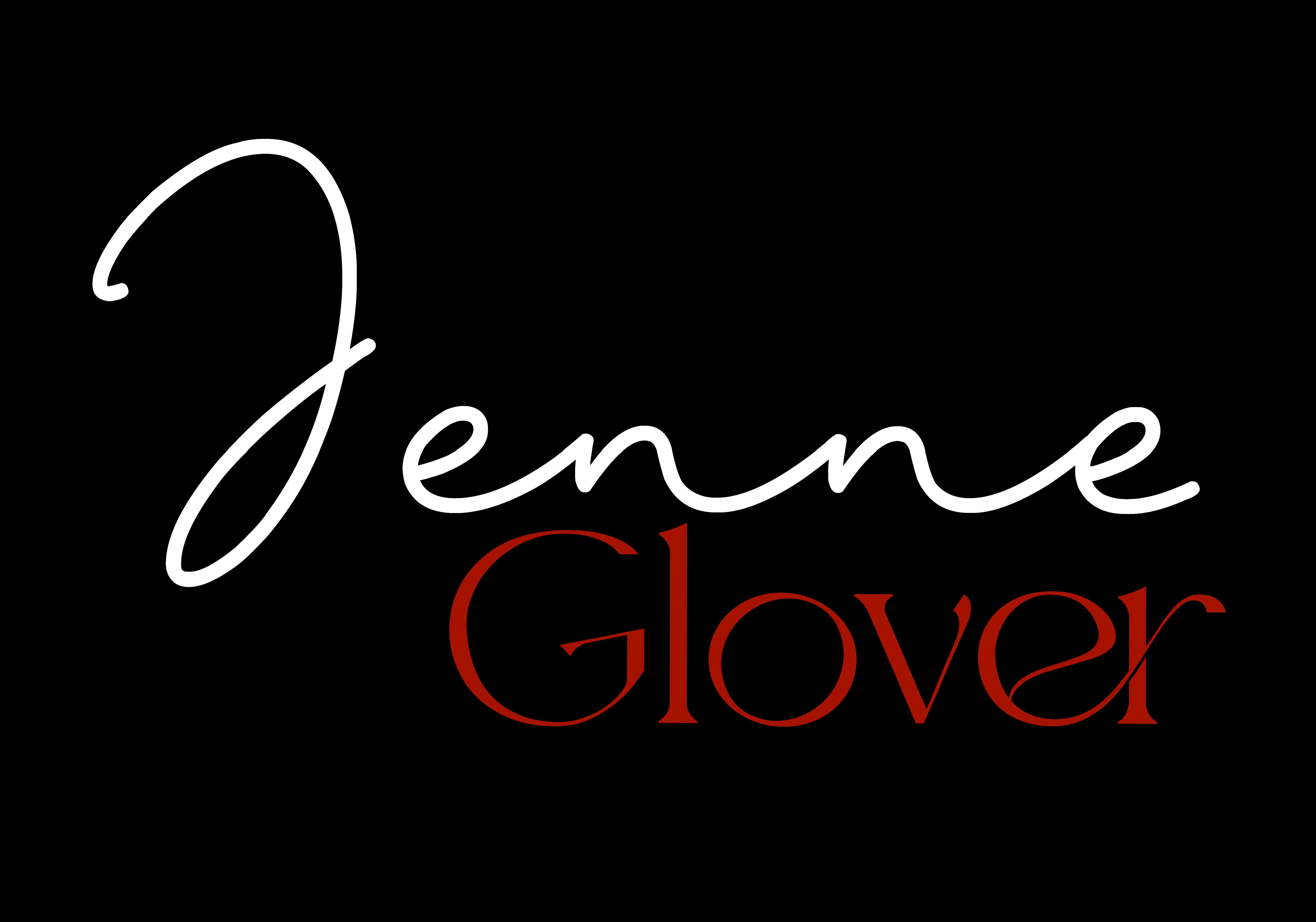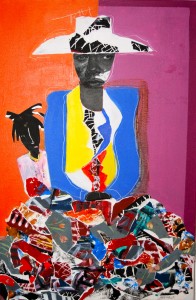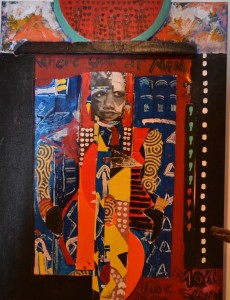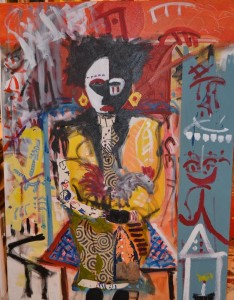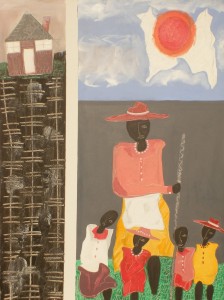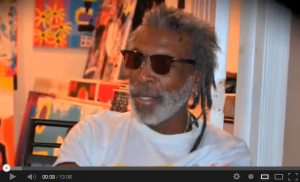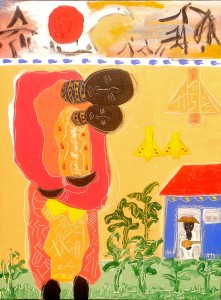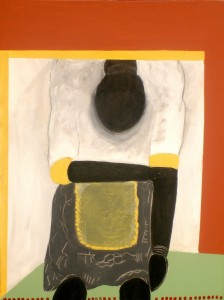In This Issue…
• Editor’s Perspective: Less is More, Mini Expressions Collection
• Ulysses Marshall: Master Collagist, Artist In Exile
Editor’s Perspective: Less is More, Mini Expressions Collection
A few months ago with the holiday seasoning approaching, I decided to create some miniature collage art “stocking stuffers” to sell. I’m talking about pieces that are 3” x 3” and 2.5” x 3.5”.
I had no idea the Mini Expressions Collection would consume so much of my time and attention, and would be so well received. With little space to work in, they are challenging but fun to create because once I’ve figured out what I’m going to do and how I’ll need to construct it, it doesn’t take long to complete.
They are on sale at the gift shops at the Studio Museum in Harlem and the Museum of Contemporary African Diasporan Art (MoCADA), as well as the Corridor/Rush Galleries. They retail for $100.
Here’s a sampling from a series on Africa’s influence on music:
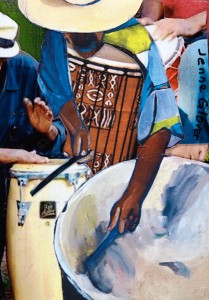 Drum Beats |
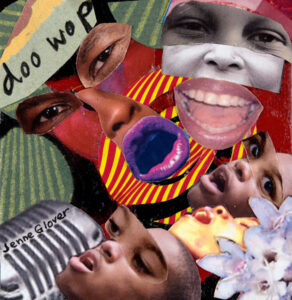 Doo Wop Harmony |
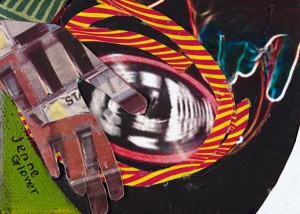 Scratching Hip Hop |
Peace!


Ulysses Marshall: Master Collagist, Artist in Exile
 Ulysses Marshall calls himself an artist in exile because he spends a lot of time alone. He says the term anchors him and gives him the space to create independently. Growing up in Vienna, Georgia, he had no playmates, so as his grandmother made patchwork quilts, Ulysses played paper dolls with cuttings from catalogs and magazines.
Ulysses Marshall calls himself an artist in exile because he spends a lot of time alone. He says the term anchors him and gives him the space to create independently. Growing up in Vienna, Georgia, he had no playmates, so as his grandmother made patchwork quilts, Ulysses played paper dolls with cuttings from catalogs and magazines.
He has been painting and doing collage art for 30+ years and recently began calling his collages paper dolls. His exhibition “Paper Dolls: Poetic Responses to the Artwork of Ulysses S. Marshall” will be on exhibit through April 13, 2013 at the Prince George’s African American Museum Gallery 110, 3901 Rhode Island Avenue, North Brentwood, Maryland. This exhibit is special to him because he knows he’s created something that has meaning to others.
Greatly influenced by how his grandmother worked spontaneously, putting her hand in a pile of scraps, and cutting and sewing them together, he strives to maintain that sense of freedom when he’s creating and he loves experimenting and taking risks. He feels every time he picks up a paint brush his grandmother is there with him. Before Mama Gussie made her transition she knew Ulysses was a painter, but she never knew how greatly she had influenced him and his work.
Earlier in his career, Ulysses painted one work independent from the next, but he found that doing a series of work is less stressful. Currently, he develops 5-7 pieces in a series. His artistic process begins by creating a storyline. Once he gets a picture in his mind of what the first image should look like the rest follow. He doesn’t begin a work by doing sketches; instead he develops the face and then decides where to place it. Although he doesn’t like to be labeled, he calls his work primitive.
If he gets stuck on a piece he works it out in his sleep and if a piece is really bothering him he’ll put it aside and work out the problem on another piece. He calls this process erasing. He doesn’t usually work on multiple canvases unless he’s stuck because he finds it more comforting to complete one task at a time. Once a piece is completed he hangs it on the wall as a reference to where the storyline’s goin. And, if he runs into a creative block he calls on Mama Gussie for help. When he’s working on his art, once the tension subsides, and he can breathe he knows he has finished the work.
Ulysses creative urges began when he was working in Buffalo, New York. While visiting the University of Buffalo campus with a friend, Ulysses visited the Knox-Albright Museum. The artwork in the museum was some of the first original art he had ever seen and he was captivated and inspired by William De Kooning’s “Woman 1.” The artwork reminded him of his grandma’s quilts only it was done in paint.
After serving in Viet Nam, Ulysses became a student of sociology at Albany State College in Georgia. When it rained he often found shelter under a large oak tree on campus and students passing by would ask him if he was an art student. His eccentric behavior reminded them of art professor, Joo-Yon Ohm-Cederberg. The professor had a reputation of being different because he talked to himself, drove around with his paintings in an ice cream truck, and his clothes were covered in paint. When Ulysses visited the art department to meet him his artistic talents were ignited; and the professor became his mentor.
When Ulysses was in his senior year his advisor suggested he change his major to art since he spent so much time in the art department and that’s what he did. Eventually, Ulysses came to Washington, DC and was accepted at the Maryland Institute College of Art (MICA) where he completed his undergraduate work and received a Phillip Morris Fellowship to complete his graduate work at MICA. He also did graduate work with Grace Hartigan at the Hoffberger School of Painting and he is the recipient of the Whitney Independent Study Fellowship in New York, as well as several Maryland State Art Council Individual Artist Awards.
Ulysses studies a lot of art books; he likes reading about artist survival skills and what motivated them to pursue their dreams. Some artists he admires are William H. Johnson, Jacob Lawrence, Renee Cox, Henri Matisse, Franz Kline, and Robert Motherwell.
Ulysses has been featured in numerous solo and group exhibitions including the Corcoran Gallery of Art, National Vietnam Veterans Museum, Reginald Lewis Museum, John Heinz History Museum, Woodmere Art Museum, International Visions Gallery, De Menil Art Gallery, and Williams College. His art works are in both private and public collections.
Professionally, his biggest challenge is having articles published about his art. He thinks this is important because it secures him a place in history and makes his work more important. He also finds it challenging that there are so few African American galleries in the area and white galleries often do not know how to accept the expressions in his work. He says the rejections motivate him and push him to continue doing what’s fun to him.
You can contact Ulysses at 301-785-4511, or at artistatwork@gmail.com. See more of his art work at http://ulyssesmarshall.com/.
